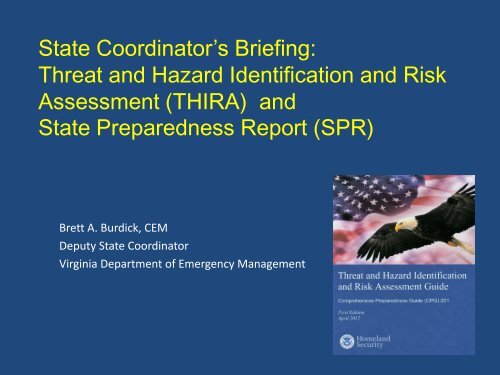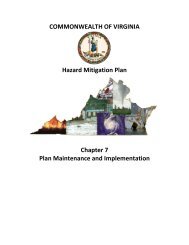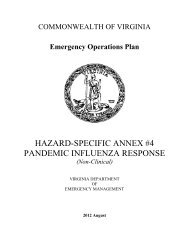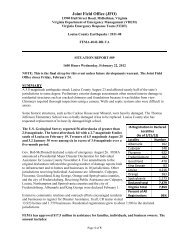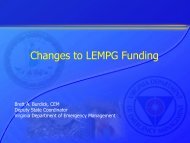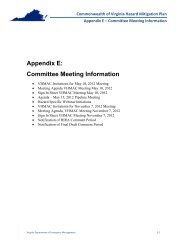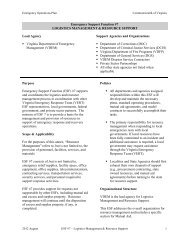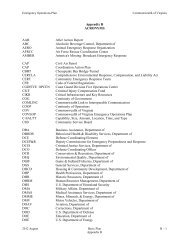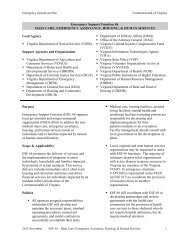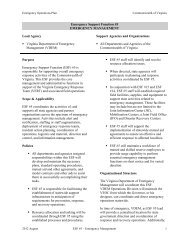Threat and Hazard Identification and Risk Assessment (THIRA)
Threat and Hazard Identification and Risk Assessment (THIRA)
Threat and Hazard Identification and Risk Assessment (THIRA)
You also want an ePaper? Increase the reach of your titles
YUMPU automatically turns print PDFs into web optimized ePapers that Google loves.
State Coordinator’s Briefing:<br />
<strong>Threat</strong> <strong>and</strong> <strong>Hazard</strong> <strong>Identification</strong> <strong>and</strong> <strong>Risk</strong><br />
<strong>Assessment</strong> (<strong>THIRA</strong>) <strong>and</strong><br />
State Preparedness Report (SPR)<br />
Brett A. Burdick, CEM<br />
Deputy State Coordinator<br />
Virginia Department of Emergency Management
<strong>THIRA</strong>/SPR<br />
•The <strong>THIRA</strong> is a FEMA m<strong>and</strong>ated self-evaluative risk<br />
analysis process designed to identify significant<br />
event Core Capability impacts, the ability of the<br />
State to meet these needs, <strong>and</strong> the desired State<br />
level for the Core Capability<br />
•It is used to establish the base <strong>and</strong> desired State<br />
values for Core Capabilities to be uploaded in the<br />
State Preparedness Report (SPR).<br />
•Effective this year, both are due to FEMA on an<br />
annual basis.
Background – PPD 8<br />
Presidential Policy Directive 8 (PPD 8) signed<br />
March 30, 2011, directed:<br />
“…the development of a national preparedness goal that<br />
identifies the core capabilities necessary for<br />
preparedness <strong>and</strong> a national preparedness system to<br />
guide activities that will enable the Nation to achieve<br />
the goal. The system will allow the Nation to track the<br />
progress of our ability to build <strong>and</strong> improve the<br />
capabilities necessary to prevent, protect against,<br />
mitigate the effects of, respond to, <strong>and</strong> recover from<br />
those threats that pose the greatest risk to the security<br />
of the Nation.”
Background – PPD 8<br />
From a National Perspective:<br />
• Ends we wish to achieve (National Preparedness Goal -<br />
September, 2011)<br />
• Means to achieve (National Preparedness System –<br />
November, 2011)<br />
– <strong>Threat</strong> <strong>Hazard</strong> <strong>Identification</strong> <strong>and</strong> <strong>Risk</strong> Analysis<br />
• Delivery: using what we build (National Preparedness<br />
System)<br />
• Reporting Progress (Annual National Preparedness<br />
Report <strong>and</strong> the State Preparedness Report)<br />
• Sustained engagement, building <strong>and</strong> sustaining<br />
preparedness (Whole Community Initiative)
Background – CPG 201<br />
<strong>Threat</strong> <strong>and</strong> <strong>Hazard</strong> <strong>Identification</strong> <strong>and</strong> <strong>Risk</strong><br />
<strong>Assessment</strong> Guide<br />
• The source document for the <strong>THIRA</strong> process<br />
– Provides steps <strong>and</strong> definitions of basic process<br />
elements
Background – CPG 201<br />
• Defines the Core Capabilities by Mission Area<br />
• Prevention (primarily terrorism)<br />
• Protection<br />
• Mitigation<br />
• Response<br />
• Recovery<br />
[Note: “Target Capabilities” seem to have gone away…]<br />
• Three basic Types of <strong>Threat</strong>s <strong>and</strong> <strong>Hazard</strong>s<br />
• Natural<br />
• Technological<br />
• Non-human caused failure of a system<br />
• Human-caused<br />
• Intentional action
Background – CPG 201
<strong>THIRA</strong> Tasking<br />
(Brett’s Simplified Interpretation)<br />
Essentially, Virginia needs to identify at<br />
least one hazard scenario to evaluate each<br />
of the 31 Core Capabilities (the maximum<br />
impact); identify any Gaps between where<br />
we are <strong>and</strong> where we want to be; <strong>and</strong> tell<br />
FEMA how we intend use future grant<br />
funds to close the Gaps.
<strong>THIRA</strong> Steps<br />
1. Identify <strong>Threat</strong>s <strong>and</strong> <strong>Hazard</strong>s of Concern<br />
– What types of natural, technological, <strong>and</strong> human caused<br />
events threaten the Commonwealth <strong>and</strong> its jurisdictions<br />
2. Give <strong>Threat</strong>s <strong>and</strong> <strong>Hazard</strong>s Context<br />
– How would the event impact the Commonwealth, the<br />
jurisdictions, <strong>and</strong> under what conditions<br />
3. Examine Core Capabilities Using <strong>Threat</strong>s <strong>and</strong> <strong>Hazard</strong>s<br />
– What is the capacity of the Commonwealth <strong>and</strong> its<br />
jurisdictions to meet the needs of the event (where we are)<br />
4. Set Capability Targets<br />
– What is the desired outcome (where we want to be)<br />
5. Apply the Results<br />
– Figure out how to proceed from where we are.
<strong>THIRA</strong>/SPR<br />
• Considerations:<br />
– A State capability target is evaluated for the State <strong>and</strong><br />
should not consider federal or EMAC assistance.<br />
– It is understood that 100% capacity for every<br />
capability cannot happen but how close to that 100%<br />
do you want to get<br />
– State Capability should include MOUs, Contracts in<br />
place, “static” capabilities<br />
– “State Capability Target minus State Capability = the<br />
Gap“ that the State wishes to address <strong>and</strong> reduce<br />
through whatever mechanism it can.
Impact ($, lives, etc.)<br />
Maximum Possible Impact for <strong>Hazard</strong><br />
Given Actual Conditions<br />
Gap<br />
Maximum Probable Impact for <strong>Hazard</strong><br />
The State Capability Target<br />
Current State Capability for <strong>Hazard</strong><br />
For Each <strong>Hazard</strong> Identified in <strong>THIRA</strong><br />
The <strong>THIRA</strong> describes how we will close this Gap <strong>and</strong> how we<br />
intend to improve State Capability through future grants.
<strong>THIRA</strong>/SPR<br />
• Distributed 10 scenarios to state agencies <strong>and</strong> a<br />
representative sample of local emergency managers<br />
• Asked that each evaluate the scenarios in terms of<br />
ability to respond to maximum probable event<br />
• Identify <strong>and</strong> quantify gaps <strong>and</strong> shortfalls<br />
• Assess impacts on 31 Core Capabilities<br />
• Identify how Virginia will close the Gap<br />
• VDEM <strong>and</strong> VAHS will compile <strong>and</strong> interpret the<br />
responses <strong>and</strong> submit the <strong>THIRA</strong>/SPR to FEMA by<br />
December 31, 2012<br />
• Update, reconsider, <strong>and</strong> improve over the next year
<strong>THIRA</strong> Steps
Questions


